Abstract
OBJECTIVE: The authors analyzed the frequency and character of postoperative complications after splenectomy in patients with hematologic malignancies, and correlated these findings with preoperative conditions that could have predicted their outcome. SUMMARY BACKGROUND DATA: Splenectomy is performed for hematologic malignancies for diagnostic and therapeutic indications. The role of splenectomy for lymphoproliferative and myeloproliferative malignancies is complex and sometimes controversial. METHODS: The medical records of 135 patients undergoing splenectomies for hematologic malignancies at Roswell Park Cancer Institute from January 1, 1984 to December 31, 1993 were reviewed retrospectively. These included Hodgkin's disease (HD), hairy cell leukemia (HCL), non-Hodgkin's lymphoma (NHL), chronic lymphocytic leukemia (CLL), chronic myelogenous leukemia (CML), and a miscellaneous group. RESULTS: The overall postoperative complication and mortality rates for all patients were 52% and 9%, respectively. The complication rate was 63% for patients whose spleens weighed greater than 2000 g, and 29% for patients whose spleens weighed less than 2000 g (p = 0.001). Seventy-three percent of the postoperative deaths were due to septic complications, only one of which was caused by an encapsulated organism. Complications occurred in less than 20% of patients with the diagnosis of HD and HCL; more than 50% of patients with NHL, CLL, and CML suffered postoperative complications. CONCLUSIONS: Splenectomy performed in patients with hematologic malignancies is a potentially morbid procedure. Splenic size was the only preoperative factor found to be predictive of postoperative complications. The complication rate differed significantly between the different diagnostic subgroups.
Full text
PDF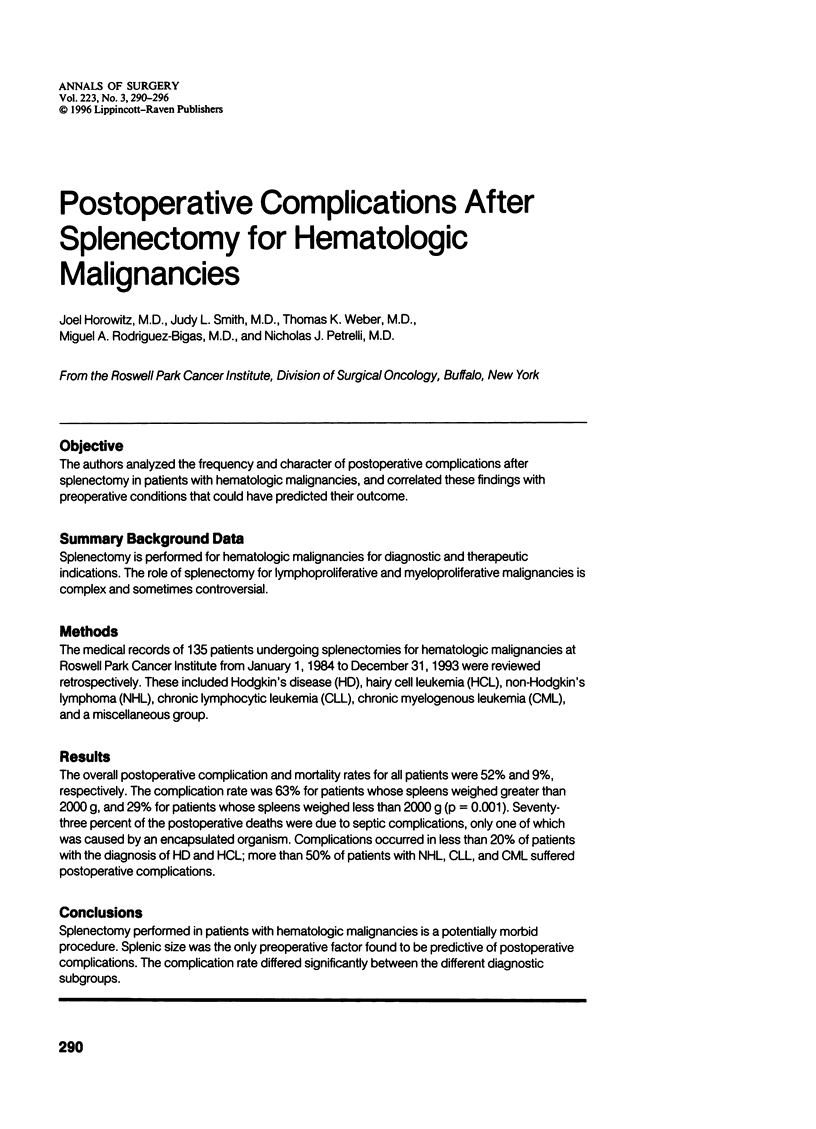
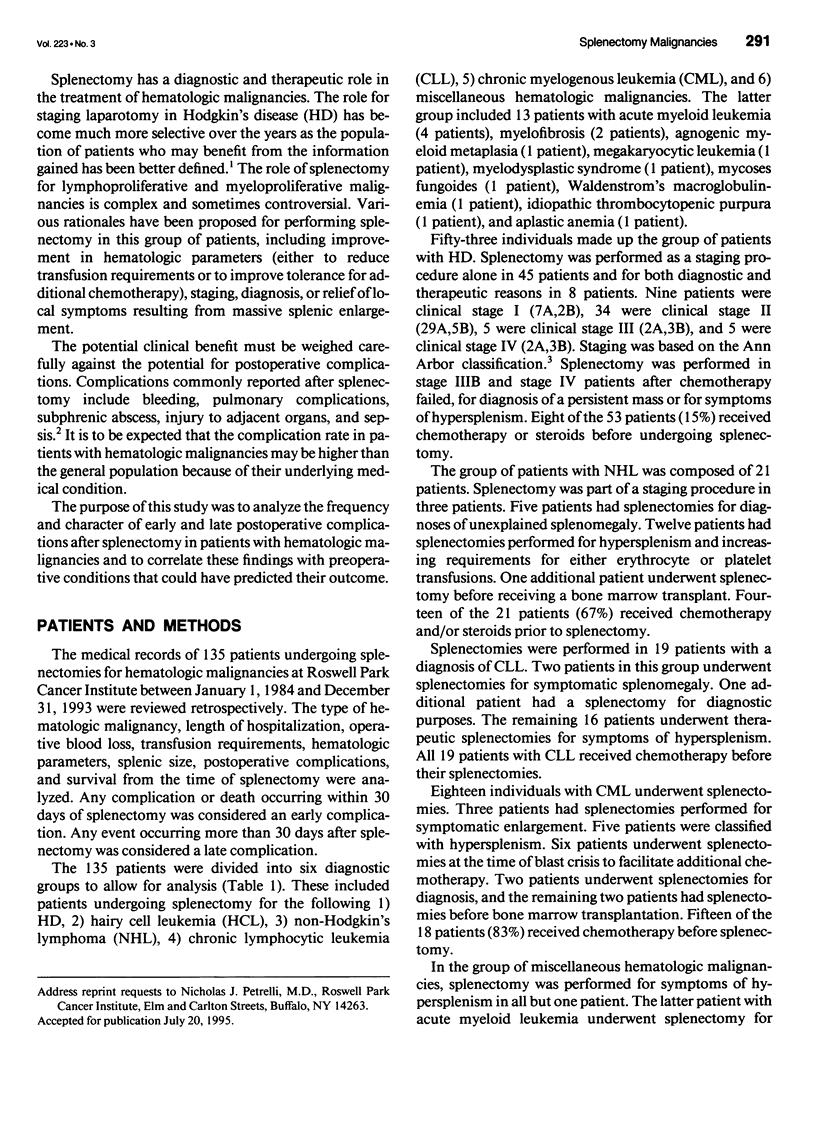
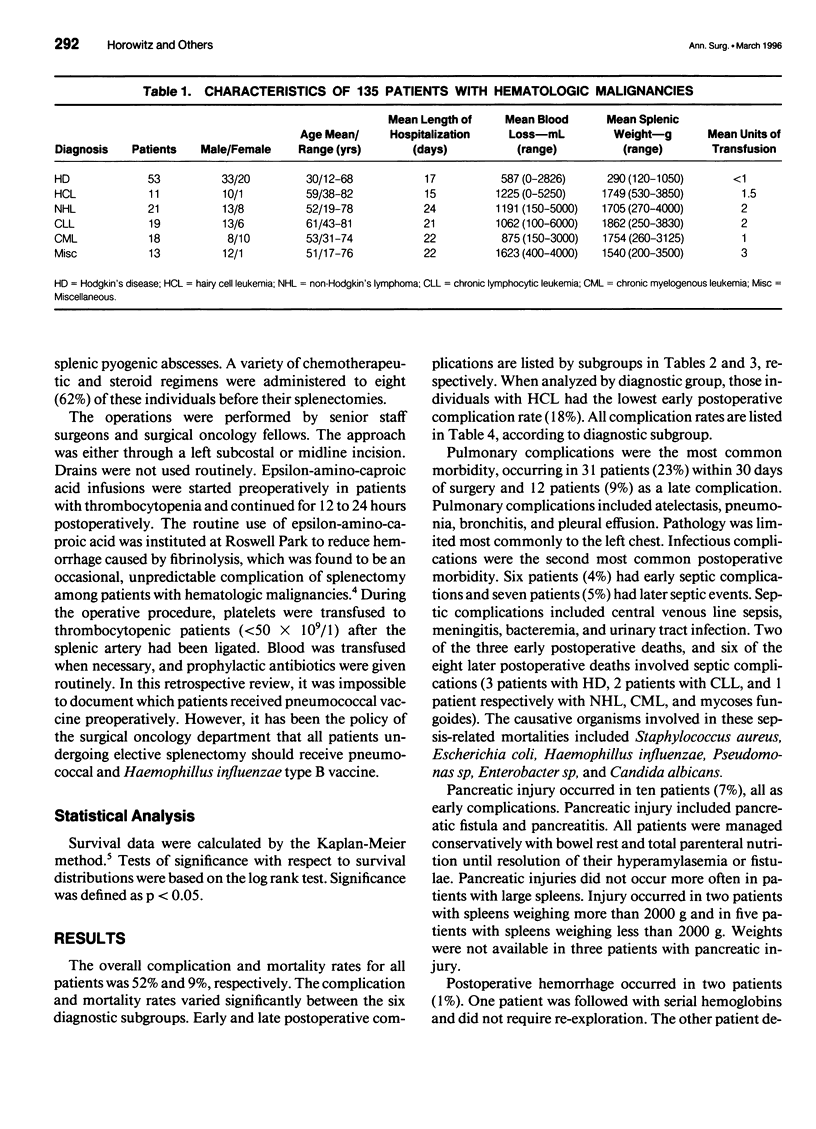
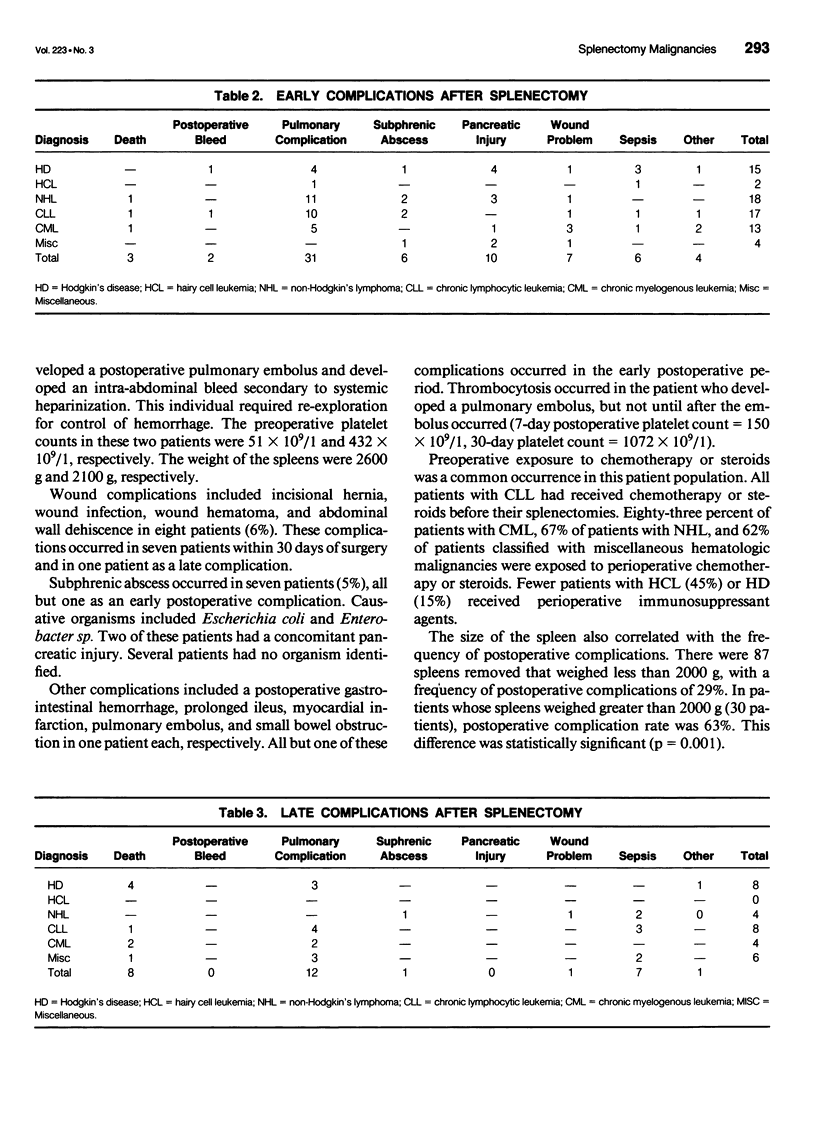

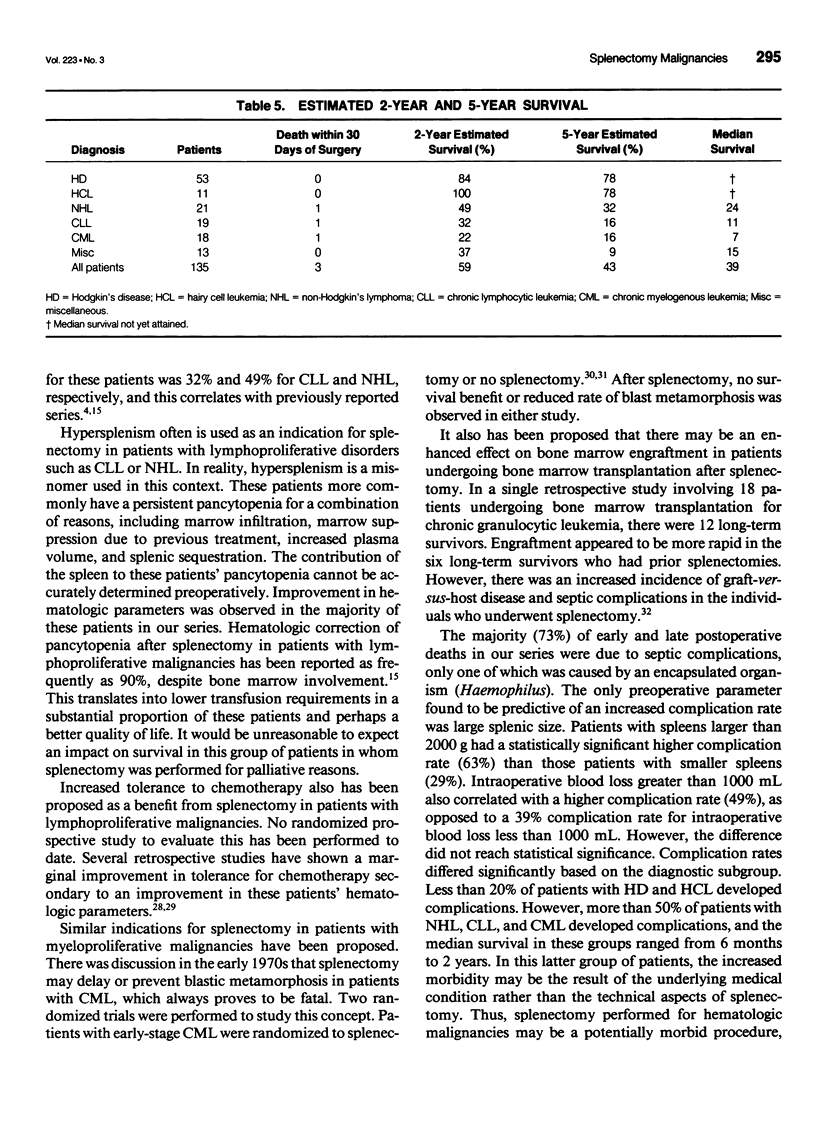
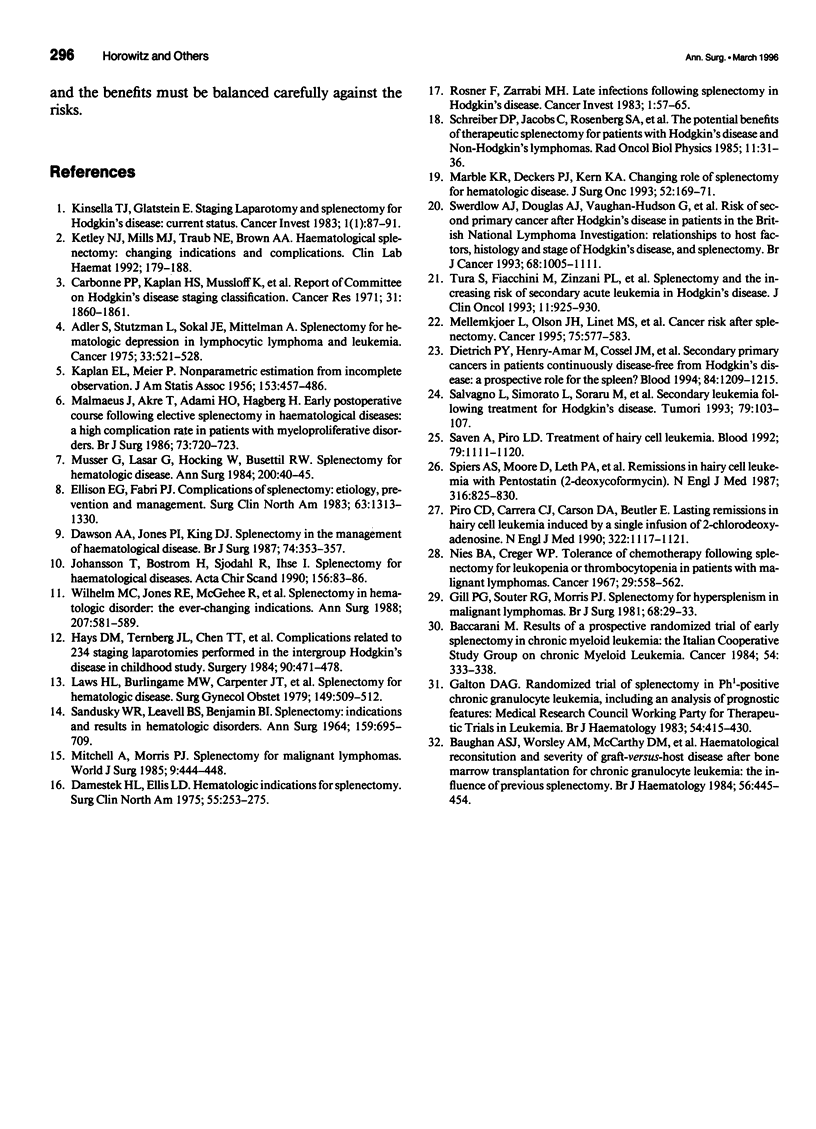
Selected References
These references are in PubMed. This may not be the complete list of references from this article.
- Adler S., Stutzman L., Sokal J., Mittelman A. Splenectomy for hematologic depression in lymphocytic lymphoma and leukemia. Cancer. 1975 Feb;35(2):521–528. doi: 10.1002/1097-0142(197502)35:2<521::aid-cncr2820350234>3.0.co;2-k. [DOI] [PubMed] [Google Scholar]
- Baughan A. S., Worsley A. M., McCarthy D. M., Hows J. M., Catovsky D., Gordon-Smith E. C., Galton D. A., Goldman J. M. Haematological reconstitution and severity of graft-versus-host disease after bone marrow transplantation for chronic granulocytic leukaemia: the influence of previous splenectomy. Br J Haematol. 1984 Mar;56(3):445–454. doi: 10.1111/j.1365-2141.1984.tb03974.x. [DOI] [PubMed] [Google Scholar]
- Carbone P. P., Kaplan H. S., Musshoff K., Smithers D. W., Tubiana M. Report of the Committee on Hodgkin's Disease Staging Classification. Cancer Res. 1971 Nov;31(11):1860–1861. [PubMed] [Google Scholar]
- Dameshek H. L., Ellis L. D. Hematologic indications for splenectomy. Surg Clin North Am. 1975 Apr;55(2):253–275. doi: 10.1016/s0039-6109(16)40580-3. [DOI] [PubMed] [Google Scholar]
- Dawson A. A., Jones P. F., King D. J. Splenectomy in the management of haematological disease. Br J Surg. 1987 May;74(5):353–357. doi: 10.1002/bjs.1800740508. [DOI] [PubMed] [Google Scholar]
- Dietrich P. Y., Henry-Amar M., Cosset J. M., Bodis S., Bosq J., Hayat M. Second primary cancers in patients continuously disease-free from Hodgkin's disease: a protective role for the spleen? Blood. 1994 Aug 15;84(4):1209–1215. [PubMed] [Google Scholar]
- Ellison E. C., Fabri P. J. Complications of splenectomy. Etiology, prevention, and management. Surg Clin North Am. 1983 Dec;63(6):1313–1330. doi: 10.1016/s0039-6109(16)43191-9. [DOI] [PubMed] [Google Scholar]
- Gill P. G., Souter R. G., Morris P. J. Splenectomy for hypersplenism in malignant lymphomas. Br J Surg. 1981 Jan;68(1):29–33. doi: 10.1002/bjs.1800680109. [DOI] [PubMed] [Google Scholar]
- Hays D. M., Ternberg J. L., Chen T. T., Sullivan M. P., Fuller L. M., Tefft M., Kung F., Gilchrist G., Fryer C., Heller R. N. Complications related to 234 staging laparotomies performed in the Intergroup Hodgkin's Disease in Childhood study. Surgery. 1984 Sep;96(3):471–478. [PubMed] [Google Scholar]
- Johansson T., Boström H., Sjödahl R., Ihse I. Splenectomy for haematological diseases. Acta Chir Scand. 1990 Jan;156(1):83–86. [PubMed] [Google Scholar]
- Ketley N. J., Mills M. J., Traub N. E., Brown A. A. Haematological splenectomy. Changing indications and complications. Clin Lab Haematol. 1992;14(3):179–188. doi: 10.1111/j.1365-2257.1992.tb00363.x. [DOI] [PubMed] [Google Scholar]
- Kinsella T. J., Glatstein E. Staging laparotomy and splenectomy for Hodgkin's disease: current status. Cancer Invest. 1983;1(1):87–91. doi: 10.3109/07357908309040936. [DOI] [PubMed] [Google Scholar]
- Laws H. L., Burlingame M. W., Carpenter J. T., Prchal J. T., Conrad M. E. Splenectomy for hematologic disease. Surg Gynecol Obstet. 1979 Oct;149(4):509–512. [PubMed] [Google Scholar]
- Malmaeus J., Akre T., Adami H. O., Hagberg H. Early postoperative course following elective splenectomy in haematological diseases: a high complication rate in patients with myeloproliferative disorders. Br J Surg. 1986 Sep;73(9):720–723. doi: 10.1002/bjs.1800730915. [DOI] [PubMed] [Google Scholar]
- Marble K. R., Deckers P. J., Kern K. A. Changing role of splenectomy for hematologic disease. J Surg Oncol. 1993 Mar;52(3):169–171. doi: 10.1002/jso.2930520310. [DOI] [PubMed] [Google Scholar]
- Mellemkjoer L., Olsen J. H., Linet M. S., Gridley G., McLaughlin J. K. Cancer risk after splenectomy. Cancer. 1995 Jan 15;75(2):577–583. doi: 10.1002/1097-0142(19950115)75:2<577::aid-cncr2820750222>3.0.co;2-k. [DOI] [PubMed] [Google Scholar]
- Mitchell A., Morris P. J. Splenectomy for malignant lymphomas. World J Surg. 1985 Jun;9(3):444–448. doi: 10.1007/BF01655280. [DOI] [PubMed] [Google Scholar]
- Musser G., Lazar G., Hocking W., Busuttil R. W. Splenectomy for hematologic disease. The UCLA experience with 306 patients. Ann Surg. 1984 Jul;200(1):40–45. doi: 10.1097/00000658-198407000-00006. [DOI] [PMC free article] [PubMed] [Google Scholar]
- Nies B. A., Creger W. P. Tolerance of chemotherapy following splenectomy for leukopenia or thrombocytopenia in patients with malignant lymphomas. Cancer. 1967 Apr;20(4):558–562. doi: 10.1002/1097-0142(1967)20:4<558::aid-cncr2820200414>3.0.co;2-l. [DOI] [PubMed] [Google Scholar]
- Piro L. D., Carrera C. J., Carson D. A., Beutler E. Lasting remissions in hairy-cell leukemia induced by a single infusion of 2-chlorodeoxyadenosine. N Engl J Med. 1990 Apr 19;322(16):1117–1121. doi: 10.1056/NEJM199004193221605. [DOI] [PubMed] [Google Scholar]
- Results of a prospective randomized trial of early splenectomy in chronic myeloid leukemia. The Italian Cooperative Study Group on Chronic Myeloid Leukemia. Cancer. 1984 Jul 15;54(2):333–338. doi: 10.1002/1097-0142(19840715)54:2<333::aid-cncr2820540226>3.0.co;2-1. [DOI] [PubMed] [Google Scholar]
- Rosner F., Zarrabi M. H. Late infections following splenectomy in Hodgkin's disease. Cancer Invest. 1983;1(1):57–65. doi: 10.3109/07357908309040933. [DOI] [PubMed] [Google Scholar]
- SANDUSKY W. R., LEAVELL B. S., BENJAMIN B. I. SPLENECTOMY: INDICATIONS AND RESULTS IN HEMATOLOGIC DISORDERS. Ann Surg. 1964 May;159:695–710. doi: 10.1097/00000658-196405000-00007. [DOI] [PMC free article] [PubMed] [Google Scholar]
- Salvagno L., Simonato L., Sorarù M., Bianco A., Chiarion-Sileni V., Aversa S. M., Camporese R., Garofolin P., Fiorentino M. Secondary leukemia following treatment for Hodgkin's disease. Tumori. 1993 Apr 30;79(2):103–107. doi: 10.1177/030089169307900204. [DOI] [PubMed] [Google Scholar]
- Saven A., Piro L. D. Treatment of hairy cell leukemia. Blood. 1992 Mar 1;79(5):1111–1120. [PubMed] [Google Scholar]
- Schreiber D. P., Jacobs C., Rosenberg S. A., Cox R. S., Hoppe R. T. The potential benefits of therapeutic splenectomy for patients with Hodgkin's disease and non-Hodgkin's lymphomas. Int J Radiat Oncol Biol Phys. 1985 Jan;11(1):31–36. doi: 10.1016/0360-3016(85)90359-1. [DOI] [PubMed] [Google Scholar]
- Spiers A. S., Moore D., Cassileth P. A., Harrington D. P., Cummings F. J., Neiman R. S., Bennett J. M., O'Connell M. J. Remissions in hairy-cell leukemia with pentostatin (2'-deoxycoformycin). N Engl J Med. 1987 Apr 2;316(14):825–830. doi: 10.1056/NEJM198704023161401. [DOI] [PubMed] [Google Scholar]
- Tura S., Fiacchini M., Zinzani P. L., Brusamolino E., Gobbi P. G. Splenectomy and the increasing risk of secondary acute leukemia in Hodgkin's disease. J Clin Oncol. 1993 May;11(5):925–930. doi: 10.1200/JCO.1993.11.5.925. [DOI] [PubMed] [Google Scholar]
- Wilhelm M. C., Jones R. E., McGehee R., Mitchener J. S., Sandusky W. R., Hess C. E. Splenectomy in hematologic disorders. The ever-changing indications. Ann Surg. 1988 May;207(5):581–589. doi: 10.1097/00000658-198805000-00012. [DOI] [PMC free article] [PubMed] [Google Scholar]


